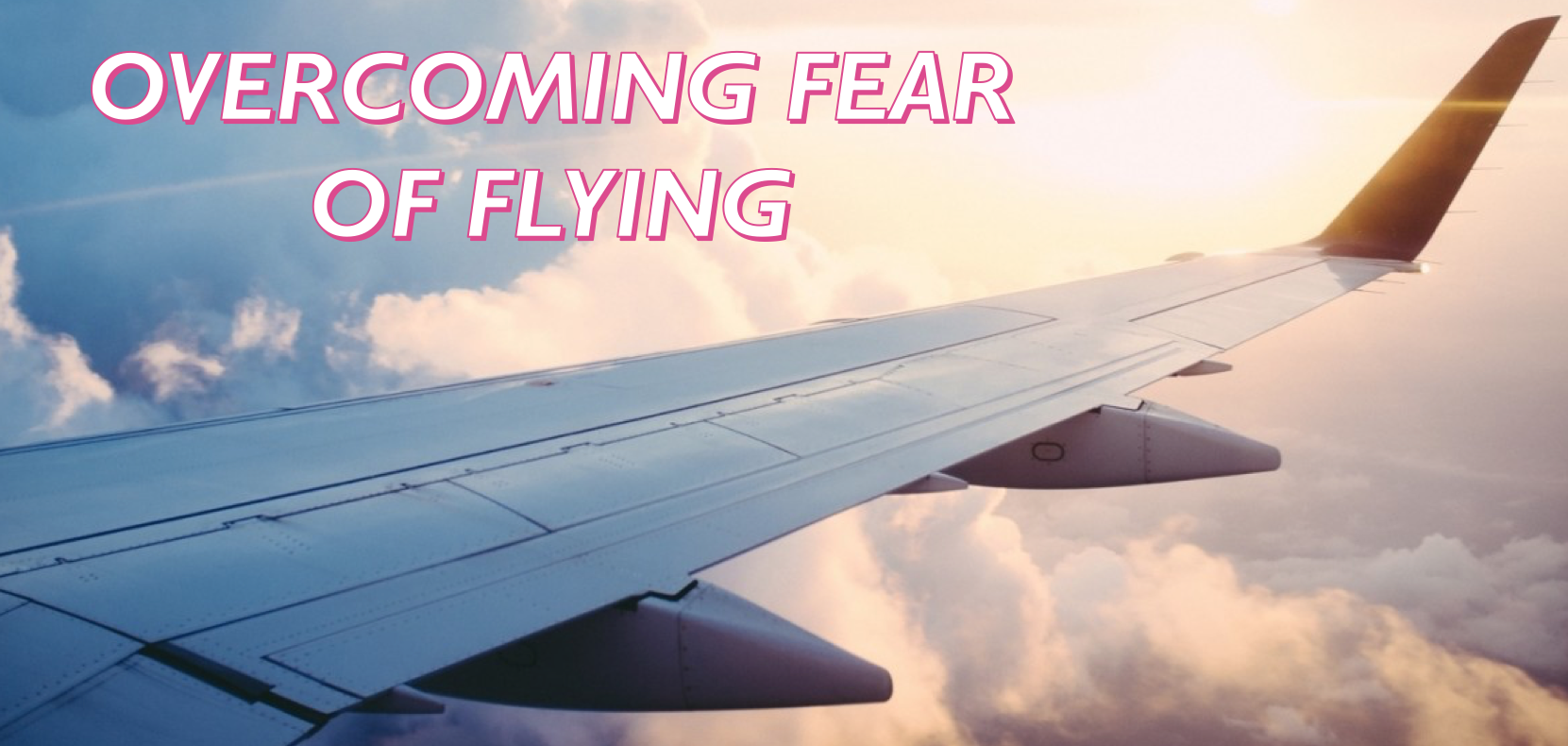Fear of flying is more common than you think. It hits one person in three. It can start due to a turbulent flight, but also for no apparent reason.
NOT IN CONTROL
The average age of onset is twenty-seven. That’s according to research at SOAR, Inc whose president, licensed therapist and retired airline captain Tom Bunn says flying gets difficult as we mature.
“We become more aware that something beyond our control could end our life. Being in control becomes important. We feel in control when we drive, but not when we fly. Though flying is safer, lack of control troubles us.”
NO WAY TO ESCAPE
Captain Bunn says, “The most basic way we control feelings is with our own two feet. If something interests us, we walk over and check it out. If something threatens us, we back away. But, if we feel the need to escape and can’t, we panic. For many anxious fliers, the mere thought of being unable to escape causes panic.”
5 TIPS FOR FEARFUL FLIERS
The 5-4-3-2-1 Exercise
This is a focusing exercise. Use it to occupy your mind so disturbing thoughts can’t take hold.
Sit or recline comfortably. Focus on some object in front of you. Keep your focus on that throughout the exercise. (If your eyes drift off, just bring them back.) Do it out loud first. Then, try it silently. See if one works better for you than the other.
- Say “I see” and name something in your peripheral vision.
- Say “I see” and name something else in your peripheral vision.
- Continue until you have made five statements.
For example: I see the lamp, I see the table, I see a spot on the lamp shade, I see a book on the table, I see a picture on the table.
- Say “I hear” and name something you hear.
- Say “I hear” and name something else you hear.
- Continue until you have made five statements.
NOTE: you will have to repeat something if there are not five different things you can hear.
- Say “I feel” and name something you feel. (not internal, like heart pounding or tension, but external).
- Say “I feel” and name something else you feel.
- Continue until you have made five statements.
For example: I feel the chair under me, I feel my arm against my leg, etc.
That completes one cycle. It takes intense concentration. That is exactly what you want. As you concentrate on non-threatening things, the “fight or flight” hormones that were in your body when you started the exercise get burned off.
As they get used up, you get more relaxed. See, you don’t have to MAKE yourself relax; as the old ones get used up, you just get more relaxed.
What about the next cycle? If you always made five statements, you soon could do the exercise WITHOUT intense concentration, and your mind could drift back to “bad” thoughts.
We keep concentration intense by making one change each cycle. Instead of doing five statements again, do four statements. Then, in the next cycle, do three statements.
Then, in the next cycle, do two statements. Then, in the next cycle, do one statement. Then, in the next cycle, go back to five, etc.
Stop when you are as relaxed as you want to be. If you want to be more relaxed – or to fall asleep – continue. If you lose count, that is a good sign because it means you are getting so relaxed that you are losing count.
For more help, see the 5-4-3-2-1 Video.

Avoid Imagination
Keep the “visual channel” of your mind fully occupied with something concrete to keep imagination from gaining a foothold.
Buy several magazines with splashy color pictures. Just flip through the pictures to keep the “visual” part of your mind busy. This is a great time to focus on needlepoint or puzzles, if you like those activities.
Bring a portable device with movies or video games. It is one thing to avoid imagination and another thing to try to keep the flight out of mind.
Don’t expect to be able to stay distracted when the plane drops, the amygdala will release stress hormones whether you are distracted or not. Distraction ends when turbulence begins. Don’t depend on distraction to work.
If turbulence is a problem for you, nothing will fix that other than automatic control.
Though breathing exercises are widely recommended, research shows they are nothing more than a distraction, with one exception: a calming system is briefly activated during exhale.
Extending the exhale extends the calming effect. If you find yourself having breathing difficulty, breath in normally, and then exhale slowly as you count one-thousand-one, one-thousand-two, one-thousand-three, one-thousand-four, one-thousand-five.
Meet The Captain
This is equal in importance to all the other tips combined. If you don’t do this one, you only have yourself to blame for an awful flight, because it works.
Tell the gate agent you need to board early because you are an anxious flier and need to speak to the captain. Some gate agents will help you do this and some won’t. If the agent will, stay nearby so the agent doesn’t forget you.
If the gate agent will not board you early, ask the agent to point out to you where you will be getting on the plane.
Then position yourself right by the entrance. When boarding (for first class passengers, elderly passengers, passengers with kids, or people who need extra time – that’s you) is announced, immediately step forward and board.
Don’t go to your seat. Instead, find a flight attendant who is not tied up directing people to their seats. Tell the flight attendant that you are an anxious flier and are working on it with someone who says it is very important that you meet the captain.
Explain that you understand about security, so you want him/her to ask the captain for you, while you wait right there.
- DO NOT APPROACH THE COCKPIT ON YOUR OWN. WAIT FOR A FLIGHT ATTENDANT.
- EVEN IF THE CAPTAIN OR FLIGHT ATTENDANT SIGNAL YOU TO COME IN, A SKY MARSHALL SEATED TO THE SIDE MIGHT NOT SEE THAT. WAIT TO BE ACCOMPANIED.
Meeting the captain keeps you from feeling alone. It also puts you in personal contact with control. You will sense their competence and confident.
It helps to know they – also – want to get back home to their family, and they have been doing so for years. They will make extra announcements for you.
Know About Noise Abatement
On some takeoffs, we reduce power after reaching about one thousand feet (roughly twenty-five seconds after liftoff), which can be frightening if you don’t know what it’s all about.
Ask the captain when you meet him or her if the power will be changed significantly after take-off, and ask how it will feel.
The Plane Can’t Fall Because the Air is as Thick as Jell-O
This great tip is a “must see” video. Go to this link

TIPS AREN’T ENOUGH FOR EVERYONE
If a person’s fear of flying is mild, tips on the web may be helpful. But for a person who panics, tips do nothing. Even breathing exercises – often recommended by therapists – won’t stop panic when turbulence starts.
That is because the amygdala, the part of the brain that releases stress hormones, zaps the anxious flier each and every time the plane drops no matter how hard they try to stay distracted. Stress hormones build up and cause panic.
THE TURBULENCE PROBLEM
“Turbulence” was our number problem until we found a way to shut down the amygdala from the time you board until and the flight is over. People are truly astounded when, to their disbelief, they complete their first flight in control of their feelings.

TEN-THOUSAND SUCCESSFUL CLIENTS
Bunn has been at this for a while, over thirty-five years. In that time, he tried every known method.
“Every one of them helped some people some. But all of the existing methods put together didn’t help people who were claustrophobic or who experienced panic on the flight. To help them, I spent years looking for an answer. After I found it, about ten-thousand formerly fearful fliers have had the whole world opened up to them.”
LOTS OF FREE HELP
For people with mild problems, the free help on the SOAR Web site may be enough.
See these videos.
And read the articles in the SOAR Library.
Every Wednesday night SOAR hosts a chat and a free group phone counseling session. Details here.
FLYING SOON?
A condensed course is available for immediate online viewing and downloading. Read more.



 En
En Es
Es Fr
Fr